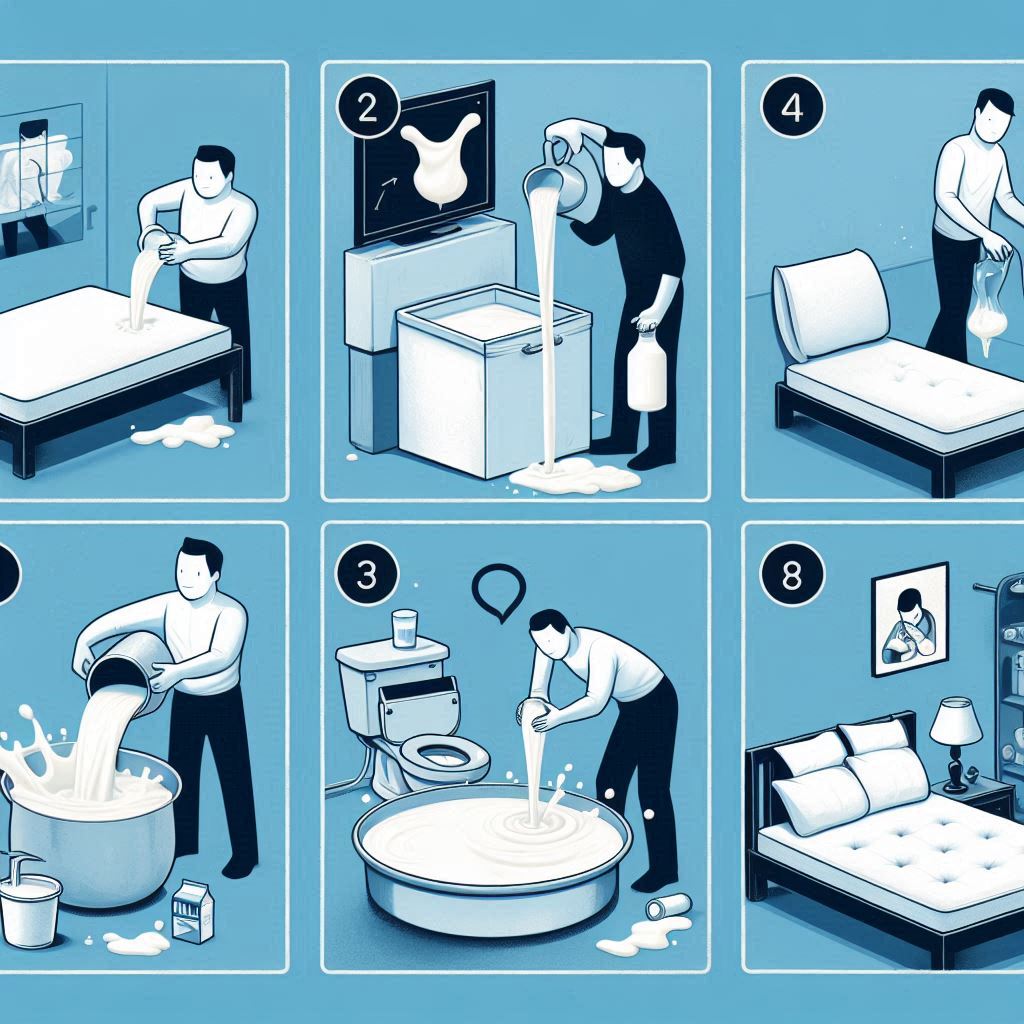Spills happen, and when they involve milk on a mattress, it can lead to unpleasant odors and potential staining if not addressed promptly and adequately. Whether it’s a result of a late-night feeding or an accidental spill, dealing with milk on a mattress requires quick action and the right approach to remove the liquid and prevent lingering odors effectively. In this article, we’ll explore step-by-step instructions on how to get milk out of a mattress, along with tips to minimize damage and restore freshness.
Step-by-Step Guide
Act Quickly
- As soon as you notice the milk spill, act promptly to prevent it from seeping more deeply into the mattress fibers.
- The longer the milk sits, the more challenging it becomes to remove and the greater the risk of odors and stains.
Blot the Area
- Use clean paper towels or a white cloth to blot up as much spilled milk as possible.
- Avoid rubbing the milk into the mattress, as this can spread the liquid and make removing it more difficult.
Apply a Cleaning Solution
- Mix a solution of mild dish soap and warm water in a spray bottle.
- Lightly mist the affected area with the cleaning solution, ensuring it does not saturate the mattress.
Blot and Rinse
- Using a clean cloth or sponge, gently blot the stained area to lift the milk and clean the solution.
- Rinse the cloth or sponge frequently and continue blotting until the milk residue is no longer visible.
Absorb Excess Moisture
- Once the milk stain is removed, use clean, dry towels to absorb any excess moisture from the mattress.
- Press down firmly to extract as much liquid as possible.
Air Dry
- Allow the mattress to air dry thoroughly in a well-ventilated area, preferably with sunlight exposure.
- Use fans or open windows to promote air circulation and speed up drying.
Deodorize
- To eliminate any lingering odors, sprinkle baking soda over the cleaned area and let it sit for several hours or overnight.
- Vacuum the mattress to remove the baking soda residue and leave it smelling fresh.
Tips to Remember
- Avoid using hot water or steam cleaners, as they can set stains and odors into the mattress fibers.
- Test any cleaning solution on a small, inconspicuous mattress area first to ensure compatibility and prevent damage.
- Consider using a mattress protector to prevent future spills and protect your mattress from stains and odors.
Frequently Asked Questions (FAQs)
Q1: What is the best way to remove milk from a mattress?
A: The best way to remove milk from a mattress is to act quickly, blot up the liquid with clean paper towels or a cloth, apply a mild cleaning solution, blot and rinse the area, absorb excess moisture, air dry the mattress, and deodorize if necessary.
Q2: Can I use hot water or steam cleaners to remove milk stains from a mattress?
A: Hot water or steam cleaners on a mattress are not recommended to remove milk stains, as they can set the stains and odors into the fibers, making them more challenging to remove.
Q3: What cleaning solution should I use to remove milk stains from a mattress?
A: A solution of mild dish soap and warm water removes milk stains from a mattress. Mix the solution in a spray bottle and lightly mist the affected area before blotting and rinsing.
Q4: How do I prevent lingering odors after removing milk from a mattress?
A: To prevent lingering odors, sprinkle baking soda over the cleaned area and let it sit for several hours or overnight before vacuuming it. Baking soda helps absorb any remaining odors and leaves the mattress smelling fresh.
Q5: Can I use bleach to remove milk stains from a mattress?
A: Bleach is not recommended for mattress cleaning, as it can damage the fabric and discolor the mattress. Stick to mild cleaning solutions such as dish soap and water to avoid causing further damage.
Q6: What should I do if the milk has soaked deep into the mattress?
A: If the milk has soaked deep into the mattress, removing it may be more challenging. Consider using a mattress cleaning machine or consult a professional cleaning service for assistance in such cases.
Q7: Will removing milk stains from a mattress damage the mattress?
A: When done properly, removing milk stains from a mattress should not damage it. However, to prevent damage to the fabric and padding, it’s important to use gentle cleaning methods and avoid saturating the mattress.
Q8: How can I prevent future spills and stains on my mattress?
A: Consider using a mattress protector to prevent future spills and stains on your mattress. A waterproof mattress protector can help safeguard your mattress from liquid spills, stains, and odors, prolonging its lifespan and keeping it clean and fresh.
Conclusion
In conclusion, effectively removing milk from a mattress requires swift action, gentle cleaning techniques, and patience. You can prevent stains and odors from setting in by promptly blotting up the liquid, applying a mild cleaning solution, and thoroughly drying the mattress. Remember to test any cleaning solution on a small area first, avoid using hot water or steam cleaners, and consider using a mattress protector to prevent future spills. With the right approach and attention to detail, you can restore your mattress to its clean and fresh state, ensuring a comfortable and hygienic sleep environment for years.
